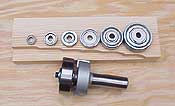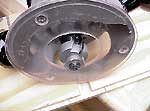This is a Veteran Owned site
Rabbet Joints and "Adjustable" Bits
Accurate, fast, simple and safeText and photos by Tom Hintz
|
||||||||||||||||||||
 |
Infinity's Bearing Kit makes one bit capable of all these cut widths, plus lets you use the bit for flush trim work as well. Click image to enlarge |
table saw or router table can present a problem in many home woodworking shops. For example, say we need a rabbet in a 5-foot-long board. To safely move that board across a table saw or router table, the cutter has to be centered in a minimum of 12 feet of clear space to insure being able to safely make the cut without the workpiece contacting anything else. A board hitting an obstruction during a cut is very dangerous and can easily ruin the workpiece or worse, cause a kickback. With a hand-held router and rabbeting bit, that same job can be done safely in little more space than the length of the board itself.
Versatility Through Bearings
Infinity Bearing/Cut-Width |
|
Bearing Diameter |
Cut-Width |
1/2" |
7/16" |
5/8" |
3/8" |
3/4" |
5/16" |
7/8" |
1/4" |
1 1/8" |
1/8" |
1 3/8" |
Flush Trim |
Some rabbet bit manufacturers offer an accessory bearing kit that greatly extends the capabilities of a single bit. By changing the diameter of the bearing, the amount of the bit's cutters exposed to the wood is precisely increased or decreased. This enables one bit to make the same cuts as a few non-adjustable bits, representing a considerable savings to the woodworker. Keep in mind that the bearings only control how much of the bit's diameter is exposed to the wood. The amount of the cutter exposed below the router baseplate remains a function of the routers depth adjustment.
In producing this story, I used the Infinity Cutting Tools Rabbet Bit (#35-850) and their Bearing Kit (#RB-155). The Infinity rabbeting bit came equipped with a 3/8"-diameter bearing that produces a ½" cut width. The Infinity Bearing Kit includes six bearings in various sizes that produce cut widths from 7/16" to 0. Installing the largest bearing converts the rabbeting bit into a flush-trim bit. (See the chart)
Another useful feature of changeable bearings is the speed with which cutter width can be changed. Unplug the router, remove an Allen screw, replace the bearing with the diameter wanted and replace the screw. In most cases, the bit never has to be removed from the (unplugged) router.
Speed and Feed
Rabbeting bits are rather large in diameter, which makes router speed (rpm) a consideration. The Infinity Rabbeting Bit is 1 3/8" in diameter and has a recommended rpm limit of 18,000 rpm. It is important for safety and performance to follow the recommendations of the bit and router manufacturers regarding router speed and the size of bit being used. If your router does not have a variable speed control, check the documentation that came with it for its operating rpm (usually listed on a plate on the router itself also) to see if it is compatible with the bit you are using.
How fast we move the router along the wood directly affects the quality of the cut produced. Move too quickly and splintering or tear out can result. Moving the router too slowly may cause burning of the wood.
Finding the proper feed rate is often a combination of feel and sound. If you are getting a clean cut with no burning or tear out, your feed rate is probably correct. The router should sound like it is "working" somewhat, not freewheeling at maximum rpm or bogging down from excessive loading.
Setting Depth
Note: Removing too much wood in one pass is a sure way to mess up any cutting operation. Cutting rabbets is no exception. If a rabbet cut is larger than ¼" by ¼," especially in hardwood, making multiple passes taking lighter cuts will be safer and more productive. It takes a little longer but the quality of the cuts is more than worth the effort.
A common rabbeting job is creating a recess in the rear of cabinet sides in which to conceal the end grain of the back panel. Since it is easiest to make this cut with the cabinet side laying flat on a table, we have to remember that in this position, the bearing controls the depth of the recess and the amount of bit exposed below the routers base regulates what will be the width.
When deciding how deep into a piece of wood to cut a rabbet, it is important to consider how much wood will remain after the cut. Removing more than half of the thickness can weaken rather than strengthen the joint. The most common rabbet depth is approximately 1/3rd of the thickness of the wood into which it is cut.
Many times, it is best to cut rabbets slightly deeper than necessary to make sanding the joint smooth easier. In the case of a rabbet in the back of a cabinet, making the cut 1/16" deeper than the panel thickness insures all of the end grain is concealed.
There are times when it is necessary to use the router with its base on the edge of a board. Trying to balance a router on such a narrow surface is difficult to say the least. Screwing a wide piece of wood to a router fence helps. To learn more about another alternative to this procedure see "Routing on the Edge" in the Tips & Tricks section of this site.
If there is a constant in woodworking, it is that situations always change. Regardless of the size of our power tool inventory, having a good rabbeting bit for your hand-held router means you will be prepared for more of the situations encountered in your shop.
Sources:
Visit the Infinity Tools web site - Click Here
Do you have a comment about this page? - Email Me!
All written, photographic and drawn materials are property of and copyright by NewWoodworker.com LLC 2000-2019. Materials may not be used in any way without the written permission of the owner.




